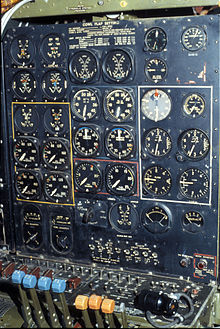Bockscar
It was assigned to the 393rd Bombardment Squadron, 509th Composite Group to Wendover Army Air Field, Utah, in April and was named after captain Frederick C. Bock.
On 9 August 1945, Bockscar, piloted by the 393d Bombardment Squadron's commander, Major Charles W. Sweeney, dropped the "Fat Man" nuclear bomb with a blast yield equivalent to 21 kilotons of TNT over the city of Nagasaki.
[1] Bockscar is now on permanent display at the National Museum of the United States Air Force, Dayton, Ohio, next to a replica of the Fat Man bomb.
[7] The Great Artiste was designated as an observation and instrumentation support plane for the second mission, while The Big Stink – flown by group operations officer Major James I. Hopkins Jr. – as a photographic aircraft.
Replacing the pump would take hours; moving the Fat Man to another aircraft might take just as long and was dangerous as well, as the bomb was live.
Bockscar reached the rendezvous point and assembled with The Great Artiste; the planes then circled for some time, but The Big Stink failed to appear.
As they orbited Yakushima, the weather planes Enola Gay (which had dropped the first atomic bomb on Hiroshima) and Laggin' Dragon reported both Kokura and Nagasaki within the accepted parameters for the required visual attack.
[17] After exceeding the original departure time limit by a half hour, Bockscar, accompanied by the instrument airplane, The Great Artiste, arrived over Kokura, thirty minutes away.
The delay at the rendezvous had resulted in clouds and drifting smoke from fires started by a major firebombing raid by 224 B-29s on nearby Yahata the previous day[18] covering 70% of the area over Kokura, obscuring the aiming point.
Three bomb runs were made over the next 50 minutes, burning fuel and exposing the aircraft repeatedly to the heavy defenses of Yahata, but the bombardier was unable to drop visually.
[15] It exploded 43 seconds later with a blast yield equivalent to 21 kilotons of TNT at an altitude of 1,650 feet (500 m), approximately 1.5 miles (2.4 km) northwest of the planned aiming point, resulting in the destruction of 44% of the city.
[20] The failure to drop the Fat Man at the precise bomb aim point caused the atomic blast to be confined to the Urakami Valley.
Arriving there, he circled for 20 minutes trying to contact the control tower for landing clearance, finally concluding that his radio was faulty.
Touching the runway hard, the heavy B-29 slewed left and towards a row of parked B-24 bombers before the pilots managed to regain control.
[27] After the war, Bockscar returned to the United States in November 1945 and served with the 509th at Roswell Army Air Field, New Mexico.
This display, a primary exhibit in the museum's Air Power gallery, includes a replica of a Fat Man bomb and signage that states that it was "The aircraft that ended WWII".





